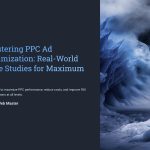 Pay-Per-Click (PPC) advertising is a powerful tool for driving targeted traffic and increasing conversions. However, without proper optimization, ad spend can quickly spiral out of control. In this guide, we’ll explore real-world case studies and actionable strategies to maximize your PPC performance, reduce costs, and improve ROI. Whether you’re a beginner or an experienced advertiser, these insights will help you refine your campaigns and stay ahead in the competitive digital advertising landscape.
Pay-Per-Click (PPC) advertising is a powerful tool for driving targeted traffic and increasing conversions. However, without proper optimization, ad spend can quickly spiral out of control. In this guide, we’ll explore real-world case studies and actionable strategies to maximize your PPC performance, reduce costs, and improve ROI. Whether you’re a beginner or an experienced advertiser, these insights will help you refine your campaigns and stay ahead in the competitive digital advertising landscape.

Understanding the Core Elements of PPC Optimization
PPC optimization involves a combination of data analysis, strategic bidding, and creative ad copy. To build a high-performing campaign, advertisers must focus on key elements such as keyword selection, audience targeting, ad copy relevance, and landing page experience.
One critical factor is Quality Score, which impacts both cost-per-click (CPC) and ad placement. A higher Quality Score means lower costs and better visibility. To improve your Quality Score, focus on:
- Keyword Relevance: Ensure your keywords match user intent.
- Ad Copy Effectiveness: Create compelling and engaging ads.
- Landing Page Optimization: Deliver a seamless user experience with fast loading times and relevant content.
A case study from an e-commerce retailer showed that refining keyword match types and A/B testing ad variations led to a 35% decrease in CPC and a 50% increase in conversion rates within three months.

Leveraging Smart Bidding for Cost Efficiency
Manual bidding can be time-consuming and inefficient. Smart Bidding, powered by machine learning, helps advertisers optimize bids based on real-time data. Google’s automated bidding strategies, such as Target CPA and Target ROAS, can significantly enhance PPC performance.
Case Study: E-Commerce Business Boosting Sales with Smart Bidding
An online fashion retailer switched from manual bidding to Target ROAS. By doing so, they:
- Achieved a 70% increase in conversion value.
- Reduced cost-per-acquisition (CPA) by 40%.
- Improved ad performance by dynamically adjusting bids based on user behavior.
To implement Smart Bidding successfully:
- Define clear conversion goals.
- Monitor bid strategy performance regularly.
- Use audience segmentation for more refined targeting.

Crafting High-Converting Ad Copies and CTAs
Ad copy plays a crucial role in PPC success. The right messaging can increase click-through rates (CTR) and drive more qualified traffic to your site. Successful ad copies share the following characteristics:
- Clear Value Proposition: Highlight what makes your product or service unique.
- Strong Call-to-Action (CTA): Encourage users to take immediate action.
- Emotional Appeal: Connect with users on a personal level.
Real-World Example: SaaS Company Doubling Its CTR
A SaaS startup optimized its ad copies by:
- Testing different headlines and descriptions.
- Incorporating numbers and statistics (e.g., “Increase Productivity by 300%!”).
- Using action-driven CTAs like “Start Your Free Trial Today!”.
The result? Their CTR increased by 120%, and their conversion rate improved by 45%.

Optimizing Landing Pages for Better Conversion Rates
Driving traffic through PPC is only half the battle. The landing page must be designed for conversions. A well-optimized landing page includes:
- Fast Load Speeds: A delay of just one second can decrease conversions by 7%.
- Clear Messaging: The headline should align with the ad copy.
- Strong Visual Hierarchy: Use images, bullet points, and white space effectively.
- Mobile Optimization: Over 60% of PPC traffic comes from mobile devices.
Case Study: Travel Agency Increasing Bookings by 80%
A travel agency revamped its landing page by:
- Reducing form fields from 8 to 4.
- Adding customer testimonials and trust badges.
- Implementing A/B testing for button colors and CTA placement.
After these changes, their conversion rate jumped by 80%.

Audience Targeting and Retargeting Strategies
Advanced audience targeting can drastically improve PPC performance. Google Ads and Facebook Ads offer multiple targeting options, including:
- Demographic Targeting: Age, gender, income level.
- Interest-Based Targeting: Target users based on their browsing behavior.
- Remarketing Campaigns: Re-engage previous visitors with customized ads.
Case Study: Retargeting Strategy Boosting Sales by 200%
A home decor brand used dynamic remarketing ads to show personalized product recommendations. This strategy resulted in:
- 200% increase in sales.
- 50% reduction in CPA.
- Higher customer retention rates.

Measuring and Analyzing PPC Performance
To continuously improve PPC campaigns, measuring key performance indicators (KPIs) is essential. The most important metrics include:
- Click-Through Rate (CTR): Indicates how well your ads attract clicks.
- Conversion Rate: Measures how many clicks result in a desired action.
- Return on Ad Spend (ROAS): Evaluates the profitability of your campaign.
- Cost-Per-Click (CPC): Helps manage ad budget effectively.
Case Study: Data-Driven PPC Optimization
A B2B software company used Google Analytics and Google Ads reports to:
- Identify underperforming keywords and adjust bids accordingly.
- Optimize ad schedules to run during peak conversion hours.
- Refine audience targeting based on user engagement data.
These changes resulted in a 60% improvement in ROAS and a 30% increase in qualified leads.
Final Thoughts
PPC advertising is a dynamic field that requires continuous learning and adaptation. By leveraging smart bidding, optimizing ad copies, refining landing pages, and using advanced audience targeting, businesses can achieve sustainable success.
Ready to take your PPC campaigns to the next level? Start implementing these strategies today and watch your advertising ROI soar.
*Capturing unauthorized images is prohibited*


